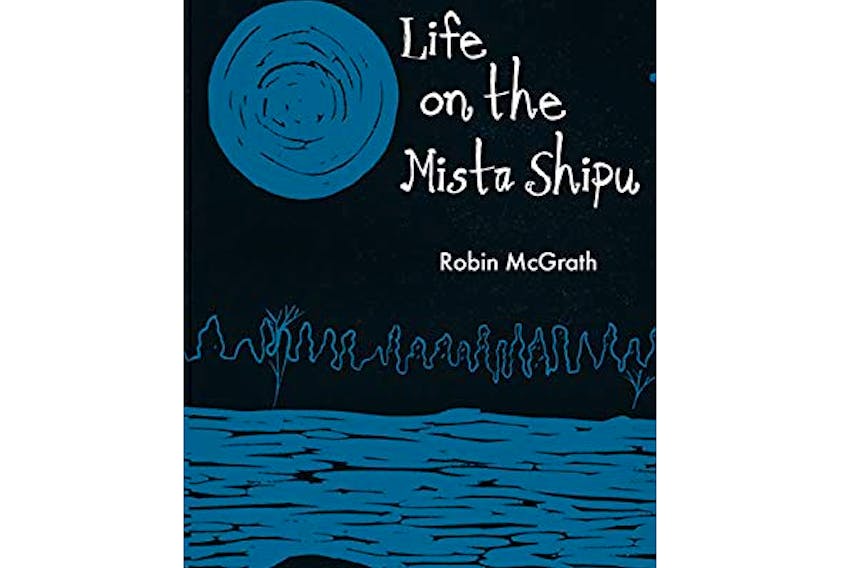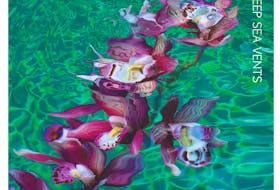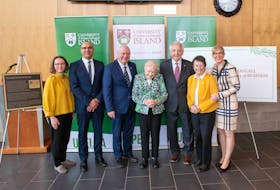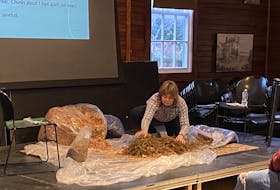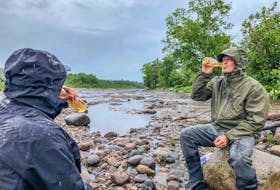Life on the Mista Shipu
By Robin McGrath
Boulder Publications
$19.95 276 pages

“Life on the Mista Shipu” is a collection of non-fiction essays and columns, all previously published, gathered here in an overview of all things Labrador (“Mista Shipu” translates to English as “Churchill River”). The 50-plus pieces are divided into 10 sections, including “Justice,” “Food,” “Visitors and Sojourners,” and “Labradorians at Home and Away.” But whether writing on characters or camping, flora or fauna, McGrath is informed and informative.
She opens with an account of her own introduction to Labrador. In 2006, her husband, John Joy, was appointed to a legal position in Goose Bay. McGrath decided the best way to meet her new home was to dive right into its wild heart. She had spent time in Nunavut, when it was the Northwest Territories, and was an experienced in the bush. So, when she signed on to travel with Elizabeth Penashue on her regular trek down the Churchill River, McGrath expected it to be arduous. Still, she was confident the conditions would be similar to what she’d met before.
Except they weren’t. Everything was a revelation. Including the sheer work it took to keep moving, keep safe and comfortable, keep fed. The labour of harvesting from this Big Land.
She was fly-bitten, exhausted, and curious. What was this place, so singular in all the world? So, she started investigating and she started writing.
Mythically Labrador is the Land God gave to Cain, so, aptly, she includes a history of murder in Labrador. “Killings and revenge killings abound in the old Inuit legends.” And without recourse to courts and prisons, perpetrators often simply had to be accommodated within their communities.
In “The Weird and Wonderful World of Labrador Bats,” McGrath builds from a single encounter with what first appeared to be a little brown bird into an engrossing explanation of how these bats, which “aren’t the first animals that come to mind when you think about Labrador,” fit in with and are key to global ecological questions and crisis. Bats (the only mammal that flies, we learn) are suffering from an infection that turns their noses white and wakes them up when they should be hibernating. They are also imperiled by myths that they carry rabies, suck blood, and entangle themselves in people’s hair.
Then there are the many applications of birch bark. “Being waterproof, birch bark also made excellent containers for food or drink. I have on my desk a birchbark drinking vessel that has served to hold my pencils and pens for almost 50 years. A bit of the spruce root stitching has been mended with sinew, but otherwise it is as clean and fresh-looking as if it were new.”
She does her research, from archival to interviews. She knows the importance of keeping it human. So, the writing, personable in tone, is also populated. Histories become stories.
For example, the pages on Sir Joseph Banks, the famed 18th-century botanist and natural philosopher who “had more than 80 plants named after him.” He surveyed Newfoundland and Labrador in 1766. The voyage was taxing for him; he was seasick, and upon reaching land laid low by fever; he also dubbed St. John’s the “most disagreeable town I ever met with,” and though he approved of the menu at a Government House ball, “the want of ladies was so great that my washerwoman and her sister were there by formal invitation.”
And “Strathcona: A North West River Love Story” is worth a feature film treatment. Never mind that he was a titled entrepreneur and adventurer who drove the last spike into the Canadian Pacific Railway — his wife, Isabella Hardisty, a spirited tour de force of daring international romance, steals that show.
McGrath also deftly contextualizes the past, via for example the First World War, or the evolving use and concept of “Eskimo.” This is particularly nicely deciphered in articles about “Anauta: Labrador’s Grey Owl” and “Ernie Lyall: The White Man Who Wasn’t,” people who, at various times and for various reasons, flowed between calling themselves or being accepted as white or Indigenous.
McGrath’s writing enlivens the page, giving her subjects voice and volume, and some of what she relates is truly amazing. For instance “… Newfoundland and Labrador had, until recently, the highest death rate from avalanches in the country.”
The book is designed with a scattering of woodcut illustrations, and a through index.
McGrath has considerable breadth with prose. This is her 24th book, including novels and history; she’s also written for stage. While generated in Labrador (obviously) the topics here are universal, attentive to both human and nature and especially where the twain do meet.
Joan Sullivan is editor of Newfoundland Quarterly magazine. She reviews both fiction and non-fiction for The Telegram.

